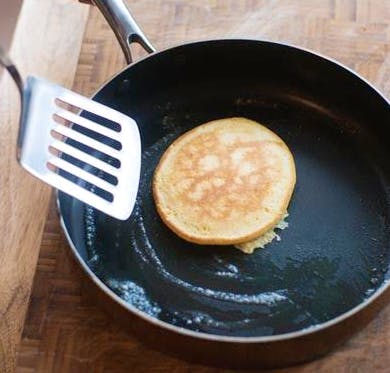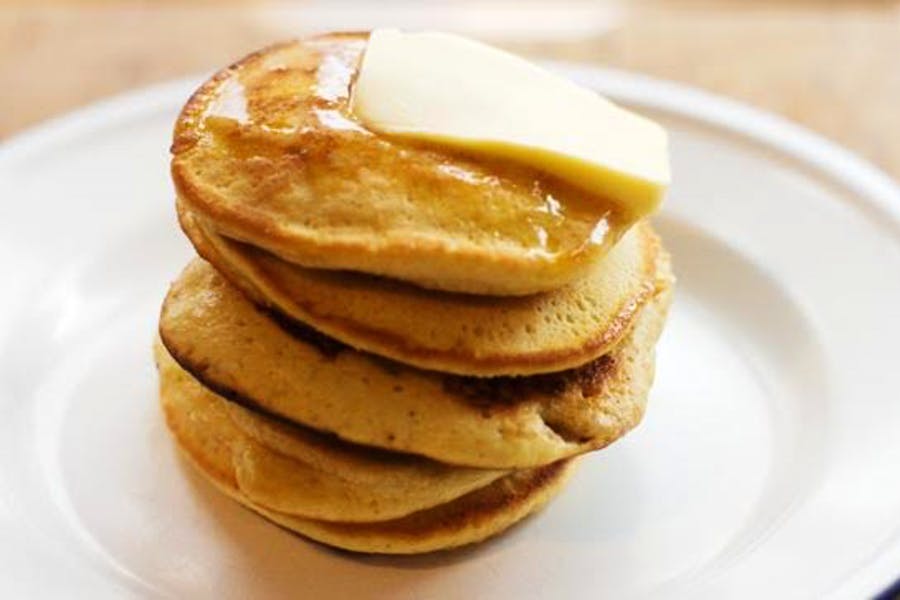There is something terribly cheering about Scotch pancakes. Even the best normal pancakes are a bit floppy, a bit (whisper it) flabby. They give the cook the choice of eating them one by one as they cook, or resigning themselves to the reality of a mostly tepid, slightly clammy pile. Scotch pancakes are not like this.
So let’s get this straight: what are they? A Scotch pancake, sometimes known by its other name, a drop scone, is a leavened and griddled pancake. It is far thicker and smaller than its unscotched sister, and although on the face of it bears a strong a resemblance to its American sibling, it’s really rather different.
There’s more flour, for one thing, which means Scotch pancakes have more substance than the fluffier American type and that they cook with a very slight crust. Both of these factors give rise to the loveliest, most comforting, joyful feature of the scotch pancake: it can, and traditionally should be, buttered like a slice of toast. Scotch pancakes are also slightly sweeter than the American-style, which means they are designed for salty half-melted butter. Scotch pancakes should be eaten, hot and crisp, with butter dripping down your wrist. Delightfully, the robust mixture means that if you are a person who can exercise some level of perverse willpower when faced with a heap of these golden discs, they are just as delicious briefly toasted at a later time.
I was introduced to Scotch pancakes by my Brown Owl in a small church hall in Sunderland in 1995. ‘These,’ our Brown Owl told us, flipping the small pancakes with a deftness I thought achingly competent, ‘will be the staple of your university lives. They are perfect student food.’ And indeed they are: so easy, so delicious, made with staple store cupboard ingredients, and don’t require resting like the traditional pancake batter, so can satisfy an immediate craving. They need only a pan and a hob, and some kind of mixing bowl. The ingredients are cheap, and the end product is hot and filling and terribly comforting.
Many of my grown up imaginings were informed by this introduction: most revolving around being a student, free from the shackles of my kind and loving family, living, I imagined, in something resembling Sara Crewe’s attic room in A Little Princess. Only with more scotch pancakes, thrown together with adult nonchalance. Probably for handsome but courteous gentlemen callers.
But then I found myself actually at college, in a tiny, garret attic room. Prime location for scotch pancakes. But we didn’t have hobs, or pans, or fires. My childhood dream of pancake-based domesticity was, you might say, scotched. So I lived on supermarket biscuits, microwaved cheese toasties, and some questionable scrambled eggs. And the less said about my gentlemen callers, the better.
But now, aged 29, I have a hob and a pan, and I make pancakes. I think my eight-year-old self would approve. She might even think I was, if not competent, at least grown up. It goes like this…

Scotch Pancakes
Makes: 8 squat pancakes
Takes: 2 minutes
Bakes: 10 minutes on the hob
150g self raising flour
90 g caster sugar
5 g salt
60-80 ml milk
3 eggs
20 g butter (for greasing the pan)
1. Place the flour, sugar, salt and eggs into a large mixing bowl. Gently whisk together until you have a thick, firm batter, almost like a loose ball of dough. Add the milk bit by bit until the dough smooths out into a thick but pliable batter. You may not need absolutely all of the milk. It should fall off the whisk reluctantly and quite slowly. If you go too far, add a little more flour in to even it out: this isn’t a terribly precise art.
2. Heat a frying pan over a medium heat. Drop about a quarter of the butter into the pan and swirl it around a little as it melts.
3. Spoon a heaped tablespoon of batter into the pan (the pancakes should be about the size of a take-way coffee lid). Allow the pancake to cook (no prodding) until you see tiny air bubbles appear on the uncooked surface of the pancake. The pancakes are ready to flip when a gentle shove causes them to skitter slightly across the pan. Flipping is stress free here: it demands a spatula and a gentle turn. Flip! Remove from the pan when this second side also responds to a gentle shove. Repeat with new batter. Flip!
4. At some point the butter will visibly darken. Carefully wipe the pan with kitchen roll, thick enough so that you don’t burn yourself, and add a new knob of the butter, and start again. Keep going until you’ve used up all the batter.
5. Ta Dah!
Icing on the cake
We started off eating these in the traditional way, with butter and jam, but both abandoned the jam after a while. I smeared Nutella all over mine, whereas my partner prefers them with nothing but butter. Which, all things considered, is quite a good way to approach life generally.






Comments